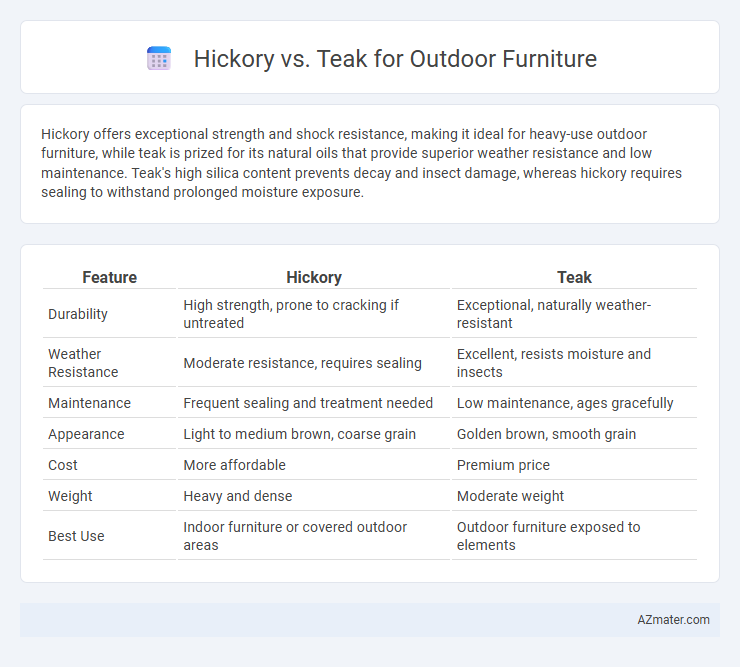Hickory offers exceptional strength and shock resistance, making it ideal for heavy-use outdoor furniture, while teak is prized for its natural oils that provide superior weather resistance and low maintenance. Teak's high silica content prevents decay and insect damage, whereas hickory requires sealing to withstand prolonged moisture exposure.
Table of Comparison
| Feature | Hickory | Teak |
|---|---|---|
| Durability | High strength, prone to cracking if untreated | Exceptional, naturally weather-resistant |
| Weather Resistance | Moderate resistance, requires sealing | Excellent, resists moisture and insects |
| Maintenance | Frequent sealing and treatment needed | Low maintenance, ages gracefully |
| Appearance | Light to medium brown, coarse grain | Golden brown, smooth grain |
| Cost | More affordable | Premium price |
| Weight | Heavy and dense | Moderate weight |
| Best Use | Indoor furniture or covered outdoor areas | Outdoor furniture exposed to elements |
Introduction to Hickory and Teak Outdoor Furniture
Hickory outdoor furniture is prized for its exceptional strength, durability, and resistance to wear, making it ideal for high-traffic outdoor spaces. Teak outdoor furniture features natural oils that provide unparalleled resistance to moisture, insects, and decay, ensuring long-lasting beauty and performance. Both hickory and teak offer distinct advantages in outdoor settings, with hickory emphasizing toughness and teak highlighting weather-resistant properties.
Wood Characteristics: Hickory vs Teak
Hickory wood is renowned for its exceptional hardness and shock resistance, making it highly durable for outdoor furniture but requires regular sealing to prevent weathering. Teak wood contains natural oils that provide superior water resistance, decay resistance, and low maintenance, ideal for outdoor environments. While hickory offers strength and impact durability, teak excels in longevity and weatherproofing due to its dense grain and high silica content.
Durability and Weather Resistance Comparison
Hickory offers exceptional hardness and impact resistance, making it highly durable for outdoor furniture but requires regular sealing to maintain weather resistance. Teak contains natural oils that provide superior moisture and insect resistance, ensuring excellent longevity with minimal maintenance. While hickory excels in strength, teak outperforms in sustained durability against harsh weather conditions and rot.
Maintenance and Care Requirements
Teak outdoor furniture requires minimal maintenance due to its natural oils that resist water, insects, and decay, needing only occasional cleaning and oiling to maintain its rich color. Hickory, while durable, demands more frequent sealing and protective treatments to prevent moisture damage and cracking over time. Proper maintenance of both wood types includes regular cleaning to avoid mold and dirt buildup, with teak generally favored for its low upkeep in outdoor environments.
Appearance and Aesthetic Appeal
Hickory features a rich, warm grain with a natural variation in color that ranges from pale amber to reddish-brown, providing a rustic and inviting aesthetic for outdoor furniture. Teak boasts a smooth, golden-brown hue that deepens over time to a beautiful silvery-gray patina, prized for its luxurious and timeless appearance. Both woods offer distinct visual appeal, with hickory delivering robust texture and teak presenting sleek elegance, making them popular choices based on desired style and outdoor environment.
Cost and Long-Term Value
Hickory outdoor furniture offers a lower upfront cost compared to teak, making it a budget-friendly option for patio sets and garden chairs. While teak boasts superior durability and natural resistance to weather, insects, and decay, its higher price is justified by its exceptional long-term value and minimal maintenance requirements. Investing in teak furniture typically results in greater cost-effectiveness over time due to its longevity and ability to maintain appearance despite exposure to outdoor elements.
Eco-Friendliness and Sourcing
Hickory is a fast-growing hardwood often sourced from sustainably managed forests in the U.S., making it a more eco-friendly choice due to its rapid renewability and lower carbon footprint. Teak, prized for its durability and natural oils, is typically harvested from tropical rainforests, where unsustainable logging practices can lead to deforestation and habitat loss despite certification efforts like FSC. Choosing hickory furniture supports responsible forestry management and reduces environmental impact compared to teak, which requires stricter scrutiny of sourcing to ensure ecological sustainability.
Suitability for Different Outdoor Climates
Hickory's dense, hard grain makes it highly resistant to wear and impact, suitable for moderate climates with limited exposure to moisture. Teak contains natural oils that provide exceptional resistance to water, mold, and UV rays, making it ideal for humid, rainy, or coastal environments. Both woods offer durability, but teak's superior weather resistance ensures longevity in harsher outdoor settings.
Comfort and Practicality
Hickory outdoor furniture offers exceptional durability and a slightly firmer seating experience, making it practical for heavy use and longevity in various weather conditions. Teak furniture is renowned for its natural oils that provide superior resistance to moisture and insects, delivering a more comfortable, smooth surface that improves with age. Both woods require minimal maintenance, but teak's natural weatherproofing often results in less frequent treatments, enhancing its practicality for outdoor comfort.
Final Verdict: Which Wood is Best for Outdoor Furniture?
Teak offers superior natural resistance to moisture, insects, and decay, making it the best choice for long-lasting, low-maintenance outdoor furniture. Hickory is strong and durable but requires regular sealing and treatment to withstand outdoor conditions effectively. For investment in weather-resistant, premium outdoor furniture, teak stands out as the optimal wood.

Infographic: Hickory vs Teak for Outdoor Furniture
 azmater.com
azmater.com